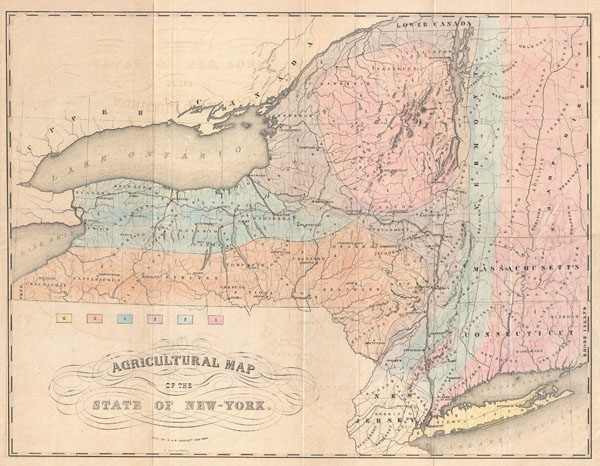This item has been sold, but you can get on the Waitlist to be notified if another example becomes available, or purchase a digital scan.
1846 Emmons Agricultural Map of New York State
NewYork-emmons-1846
Title
1846 (undated) 18.5 x 24 in (46.99 x 60.96 cm)
Description
CartographerS
Ebenezer Emmons (1799-1863) was an important American Geologist and Medical Doctor. Emmons is considered by some to be a founding father of American Geology. His work was crucial in developing a nomenclature and context for American geology as distinct from European geology. A graduate of Williams College, Ebenezer studied medicine and, as a secondary focus, geology. After graduate he set up a medical practice in Chester, Massachusetts, but never truly abandoned his love for geology. Inspired by the work of Amos Eaton, Emmons enrolled at Rensselear School (Rensselear Polytechnic), where Amos taught, to further his geological studies. After graduating, Emmons wrote several important geological treatises, textbooks, and essays. In the process he is said to have named both the Adirondacks and the Taconic Mountains. One interesting episode in Emmons life was his dispute with James Hall. At the time Emmons was chief of the New York State Geological Survey. Emmons and Hall had a very public disagreement over the dating of the Taconic Orogeny. Emmons believed that the event dated to the Cambrian age while Hall contended with the orthodoxy that the Orogeny was Ordovician. Though ultimately proven correct, the dispute resulted in a court hearing in Halls favor. Emmons was prohibited from practicing Geology in New York State. Instead he became the First Geologist of North Carolina where he lived out the remainder of his days. More by this mapmaker...
Endicott and Company (fl. c. 1828 - 1891) was a New York based family run lithography firm that flourished throughout the 19th century. The firm was founded by George and William Endicott, brothers who were born in Canton, Massachusetts. George Endicott (June 14, 1802 - 1848) trained as a lithographer under Pendleton Lithography from January 1826. He later worked as superintendent of Senefelder Company until the summer of 1828. Afterwards, in 1830, he relocated to Baltimore and partnered with Moses Swett. Endicott and Swett relocated to New York City in December 1831. They remained partners until July 1834 when the relationship dissolved. George set up shop on his own account at 359 Broadway. William Endicott (1815 - 1851), George's younger brother of 14 years, joined the firm in 1840 and was made a partner in 1845, after which the name of the firm was changed to G. and W. Endicott. George Endicott died shortly afterward, in 1848, but William continued operating the firm as William Endicott and Co. until his own 1851 death at just 35 years old. The firm was carried on by his widow Sara Munroe Endicott until it was taken over by her son, Francis Endicott, who ran the firm from 1852 to 1886. George Endicott, Jr. subsequently ran the firm from 1887 to 1891. Peters, in his important work on American lithography America on Stone writes 'it is hard to summarize the Endicotts. They did everything and did it well . . . [they] worked with and for Currier and Ives, yet in spite of all that much of their work lacks real individuality.' The Endicott firm was responsible for many 19th century views and plans of New York City and state as well as plans of Sacramento, California, and the Midwest. Learn More...

